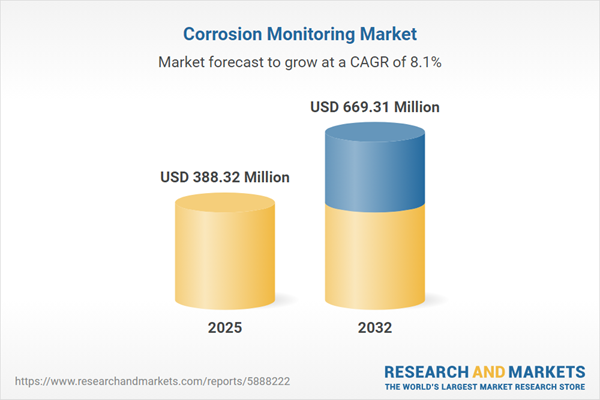Speak directly to the analyst to clarify any post sales queries you may have.
Corrosion monitoring is a decisive element for industrial leaders tasked with protecting infrastructure and optimizing asset performance. Rapid technological advances are transforming how organizations mitigate risk, maintain compliance, and sustain efficiency across complex, regulated sectors.
Corrosion Monitoring Market Snapshot
The corrosion monitoring market is undergoing sustained growth, underpinned by heightened investment in detection solutions, analytics tools, and real-time monitoring. In 2024, the global market reached USD 359.79 million, and is projected to rise to USD 669.31 million by 2032. This momentum corresponds with a compound annual growth rate of 8.06% from 2025 to 2032. Fueling this trend are increased regulatory requirements and the pressing need for continuous asset oversight, which together minimize downtime and extend asset lifespans. Core sectors, including oil and gas, chemicals, and power generation, are prioritizing advanced monitoring to secure their infrastructure, elevate safety measures, and streamline operations.
Scope & Segmentation: Corrosion Monitoring Market
- Solution Type: Both intrusive and non-intrusive monitoring systems are accessible. Intrusive models enable deep asset analysis vital for integrity management, while non-intrusive options allow continuous condition tracking in hazardous or restricted environments without disrupting operations.
- Measurement Technique: Available methods include corrosion coupons, electrical resistance probes, galvanic sensors, and linear polarization resistance. Organizations can integrate specific techniques to match their operational environment and the complexity of their infrastructure.
- Service Offering: Solutions cover hardware sensors, managed service agreements, and advanced analytics software. These offerings transform asset data into actionable intelligence, supporting a transition to predictive maintenance and timely interventions.
- End-Use Sector: Oil and gas, chemical, petrochemical, and power generation are primary end-users. All have unique safety, compliance, and operational needs, driving them to adopt segmentation-based approaches to corrosion management.
- Geographic Region: Adoption extends across the Americas, Europe, Middle East, Africa, and Asia-Pacific. Factors such as regional industrial development, digital transformation initiatives, and compliance standards significantly shape the pace and scope of implementation.
- Market Leaders: Major participants such as Emerson Electric Co., Honeywell International Inc., MISTRAS Group, ABB Ltd., Siemens AG, Schneider Electric SE, Yokogawa Electric Corporation, Endress+Hauser AG, Teledyne Technologies, and MKS Instruments set the pace with solutions engineered for durability and regulatory fit.
Key Takeaways for Senior Industrial Decision-Makers
- The choice between intrusive and non-intrusive systems provides leaders with control over asset health monitoring and helps minimize downtime in high-risk or hard-to-access settings.
- Smart sensor networks coupled with analytics platforms enhance forecasting capabilities, enabling targeted maintenance and contributing to risk reduction efforts.
- Centralizing asset and condition data allows for quicker decision cycles, streamlining maintenance planning and reducing the likelihood of unplanned disruptions.
- Partnering with experienced technology vendors supports smoother system deployments and mitigates challenges associated with meeting shifting compliance or integration demands.
- Advances in protective technologies strengthen infrastructure durabilities, supporting longer operational cycles even under adverse or corrosive environmental conditions.
- Developing a resilient supply strategy ensures continued access to critical technologies despite procurement or supply chain uncertainties, which is vital in volatile markets.
Tariff Impact and Evolving Supply Strategies
Upcoming changes to U.S. tariff frameworks in 2025 are prompting many organizations to revise sourcing strategies, with a growing emphasis on domestic supply partners. Widening supplier networks and shifting to subscription-based software are becoming key tactics for managing pricing volatility and securing ongoing access to essential monitoring technologies. These strategic adjustments empower companies to uphold stringent corrosion monitoring standards even as supply dynamics change.
Corrosion Monitoring Market: Methodology & Data Sources
This analysis draws on interviews with executive leadership, comprehensive industry surveys, reviews of academic research, and close examination of regulatory frameworks. Triangulation and cross-verification are used to ensure that strategic recommendations are both robust and actionable for executive audiences.
Why This Report Matters for Senior Leaders
- Enables leadership teams to align corrosion monitoring strategies with sector-specific compliance and operational priorities, ensuring proactive asset management.
- Equips procurement professionals with knowledge to navigate regulatory shifts and adapt sourcing strategies to address evolving market realities.
- Provides practical guidance for maximizing reliability, allocating maintenance resources effectively, and integrating monitoring within broader sustainability initiatives.
Conclusion
Integrating advanced corrosion monitoring positions organizations to meet compliance obligations, safeguard uptime, and extend asset value. Sustained monitoring capabilities equip companies to stay resilient and competitive through evolving operational landscapes.
Additional Product Information:
- Purchase of this report includes 1 year online access with quarterly updates.
- This report can be updated on request. Please contact our Customer Experience team using the Ask a Question widget on our website.
Table of Contents
3. Executive Summary
4. Market Overview
7. Cumulative Impact of Artificial Intelligence 2025
Companies Mentioned
The companies profiled in this Corrosion Monitoring market report include:- Emerson Electric Co.
- Honeywell International Inc.
- MISTRAS Group, Inc.
- ABB Ltd.
- Siemens AG
- Schneider Electric SE
- Yokogawa Electric Corporation
- Endress+Hauser AG
- Teledyne Technologies, Inc.
- MKS Instruments, Inc.
Table Information
| Report Attribute | Details |
|---|---|
| No. of Pages | 186 |
| Published | November 2025 |
| Forecast Period | 2025 - 2032 |
| Estimated Market Value ( USD | $ 388.32 Million |
| Forecasted Market Value ( USD | $ 669.31 Million |
| Compound Annual Growth Rate | 8.0% |
| Regions Covered | Global |
| No. of Companies Mentioned | 11 |









